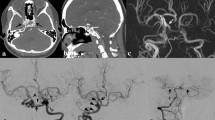Abstract
Purpose
Anatomic variations at the junction of primitive internal carotid and basilar arteries are exceedingly rare. We aimed at reporting such rare variants involving the posterior communicating artery (PComA) and the P1 segment of posterior cerebral artery (PCA).
Methods
The circle of Willis was dissected in an adult cadaver after removal of the cranial vault and cerebral hemispheres.
Results
The basilar end was rotated axially to the right. The P1 segment of the right PCA was fenestrated and occupied the interpeduncular fossa. The right PComA passed over the oculomotor nerve to join the anterior arm of the P1 fenestration. On the opposite side, the PComA coursed supero-medially to the oculomotor nerve and it had a partly duplicated posterior end, with two arms, medial, larger, and lateral, thinner, inserting successively into the left PCA.
Conclusion
Extremely rare anatomic variations of the circle of Willis should not be ignored when endovascular or microneurosurgical specific approaches are intended.


Similar content being viewed by others
Data availability
The datasets used and/or analysed during the current study are available from the corresponding author on reasonable request.
References
Alpers BJ, Berry RG, Paddison RM (1959) Anatomical studies of the circle of Willis in normal brain. AMA Arch Neurol Psychiatry 81:409–418. https://doi.org/10.1001/archneurpsyc.1959.02340160007002
Bergman RA, Tubbs RS, Shoja MM, Loukas M (2016) Bergman’s comprehensive encyclopedia of human anatomic variation. Wiley, Hoboken
Caruso G, Vincentelli F, Rabehanta P, Giudicelli G, Grisoli F (1991) Anomalies of the P1 segment of the posterior cerebral artery: early bifurcation or duplication, fenestration, common trunk with the superior cerebellar artery. Acta Neurochir (Wien) 109:66–71. https://doi.org/10.1007/BF01405701
Gregg L, Gailloud P (2017) The role of the primitive lateral basilovertebral anastomosis of padget in variations of the vertebrobasilar arterial system. Anat Rec (Hoboken) 300:2025–2038. https://doi.org/10.1002/ar.23633
Jensen CJ, Shereen R, Tubbs RS, Griessenauer C (2017) Fenestration in the P1 segment of the posterior cerebral artery. Cureus 9:e1528. https://doi.org/10.7759/cureus.1528
Parmar H, Sitoh YY, Hui F (2005) Normal variants of the intracranial circulation demonstrated by MR angiography at 3T. Eur J Radiol 56:220–228. https://doi.org/10.1016/j.ejrad.2005.05.005
Trandafilovic M, Vasovic L, Vlajkovic S, Dordevic G, Stojanovic B, Mladenovic M (2016) Fenestrations and various duplications of the posterior communicating artery in the prenatal and postnatal periods. World Neurosurg 91:172–182. https://doi.org/10.1016/j.wneu.2016.04.003
Uchino A, Ehara T, Kurita H (2019) Hypoplasia of the internal carotid artery with associated fenestration and extremely long P1 segment of the ipsilateral posterior cerebral artery diagnosed by MR angiography. Surg Radiol Anat 41:707–711. https://doi.org/10.1007/s00276-019-02212-z
Uchino A, Kamiya K, Suzuki C (2013) Duplicate origin of the posterior communicating artery diagnosed by magnetic resonance angiography. Surg Radiol Anat 35:741–743. https://doi.org/10.1007/s00276-013-1095-3
Zanini MA, Pereira VM, Jory M, Caldas JG (2009) Giant fusiform aneurysm arising from fenestrated posterior cerebral artery and basilar tip variation: case report. Neurosurgery 64:E564-565. https://doi.org/10.1227/01.NEU.0000338431.70709.81. (discussion E565)
Acknowledgements
The author acknowledges Dragoş Ionuţ Mincă, MD, PhD student, for participating in dissections.
Funding
This research did not receive any specific grant from funding agencies in the public, commercial, or not-for-profit sectors.
Author information
Authors and Affiliations
Contributions
The report has a single author.
Corresponding author
Ethics declarations
Conflict of interest
The author has no conflict of interests to declare.
Ethical statement
The research was conducted ethically in accordance with The Code of Ethics of the World Medical Association (Declaration of Helsinki).
Additional information
Publisher's Note
Springer Nature remains neutral with regard to jurisdictional claims in published maps and institutional affiliations.
Rights and permissions
Springer Nature or its licensor (e.g. a society or other partner) holds exclusive rights to this article under a publishing agreement with the author(s) or other rightsholder(s); author self-archiving of the accepted manuscript version of this article is solely governed by the terms of such publishing agreement and applicable law.
About this article
Cite this article
Rusu, M.C. Fenestrated P1 segment of posterior cerebral artery, partly duplicated posterior communicating artery. Surg Radiol Anat 45, 761–763 (2023). https://doi.org/10.1007/s00276-023-03145-4
Received:
Accepted:
Published:
Issue Date:
DOI: https://doi.org/10.1007/s00276-023-03145-4




